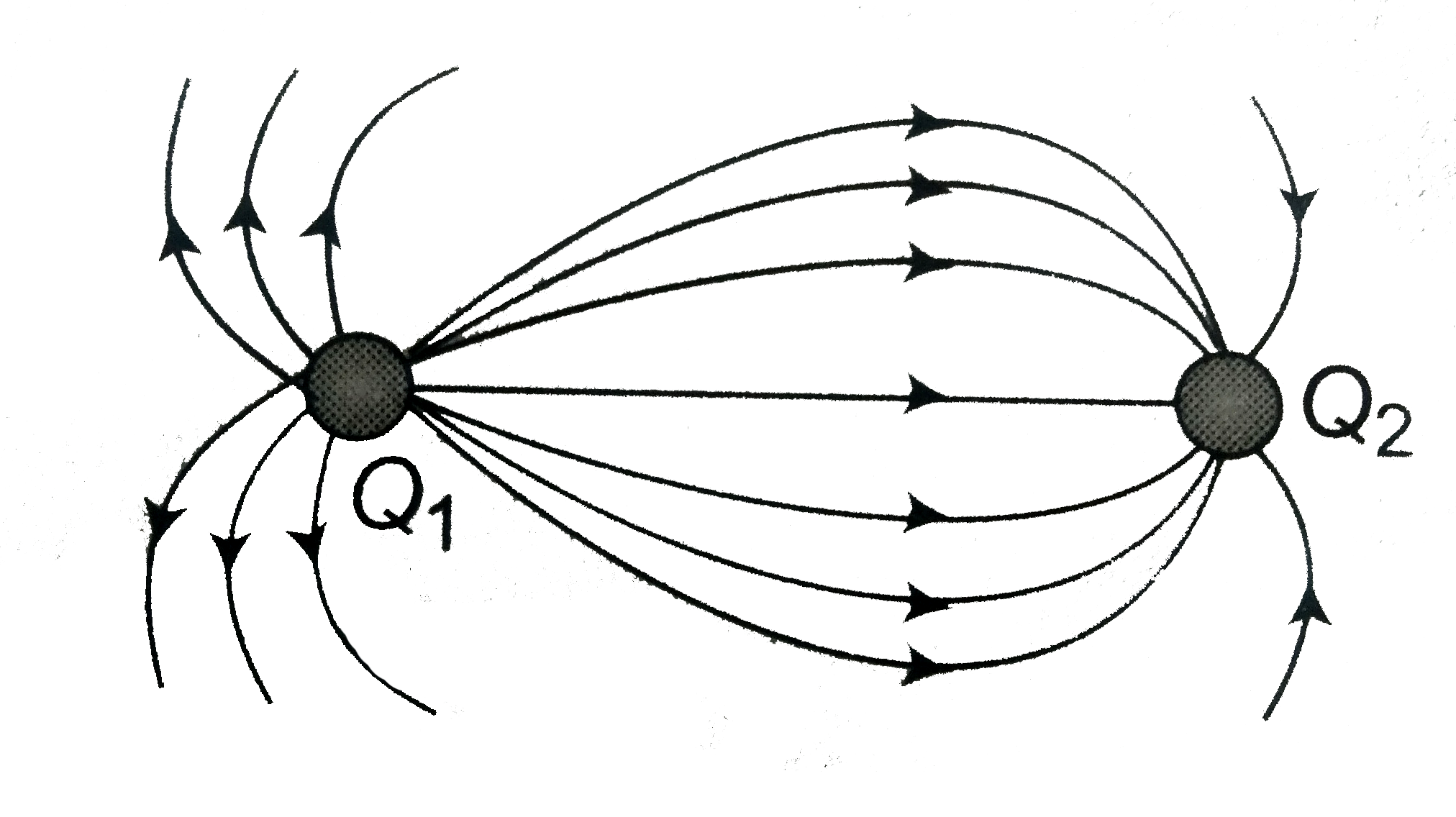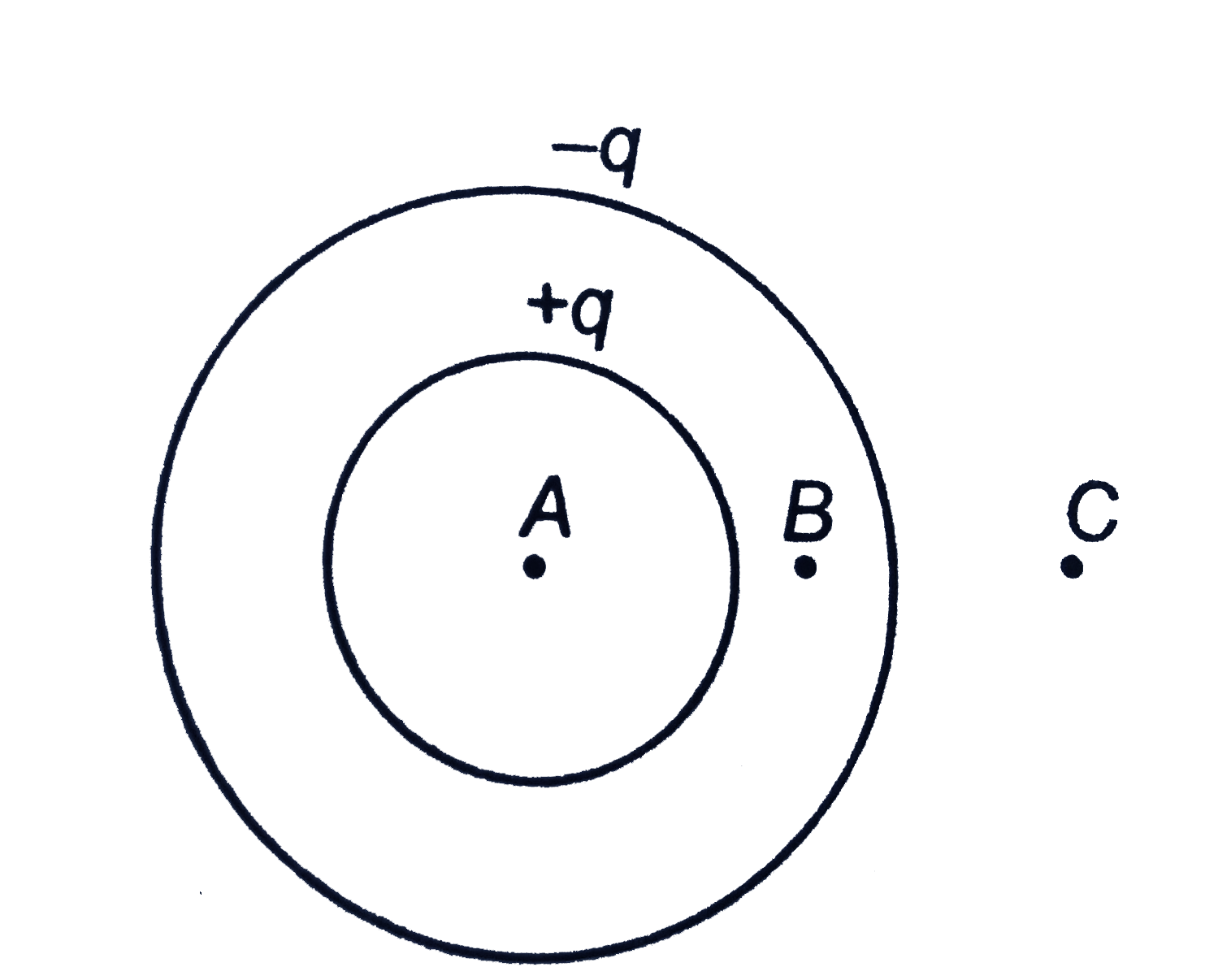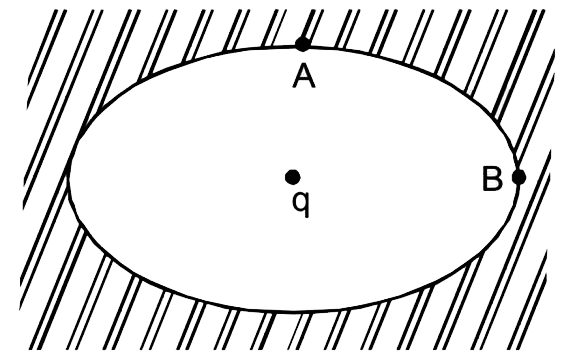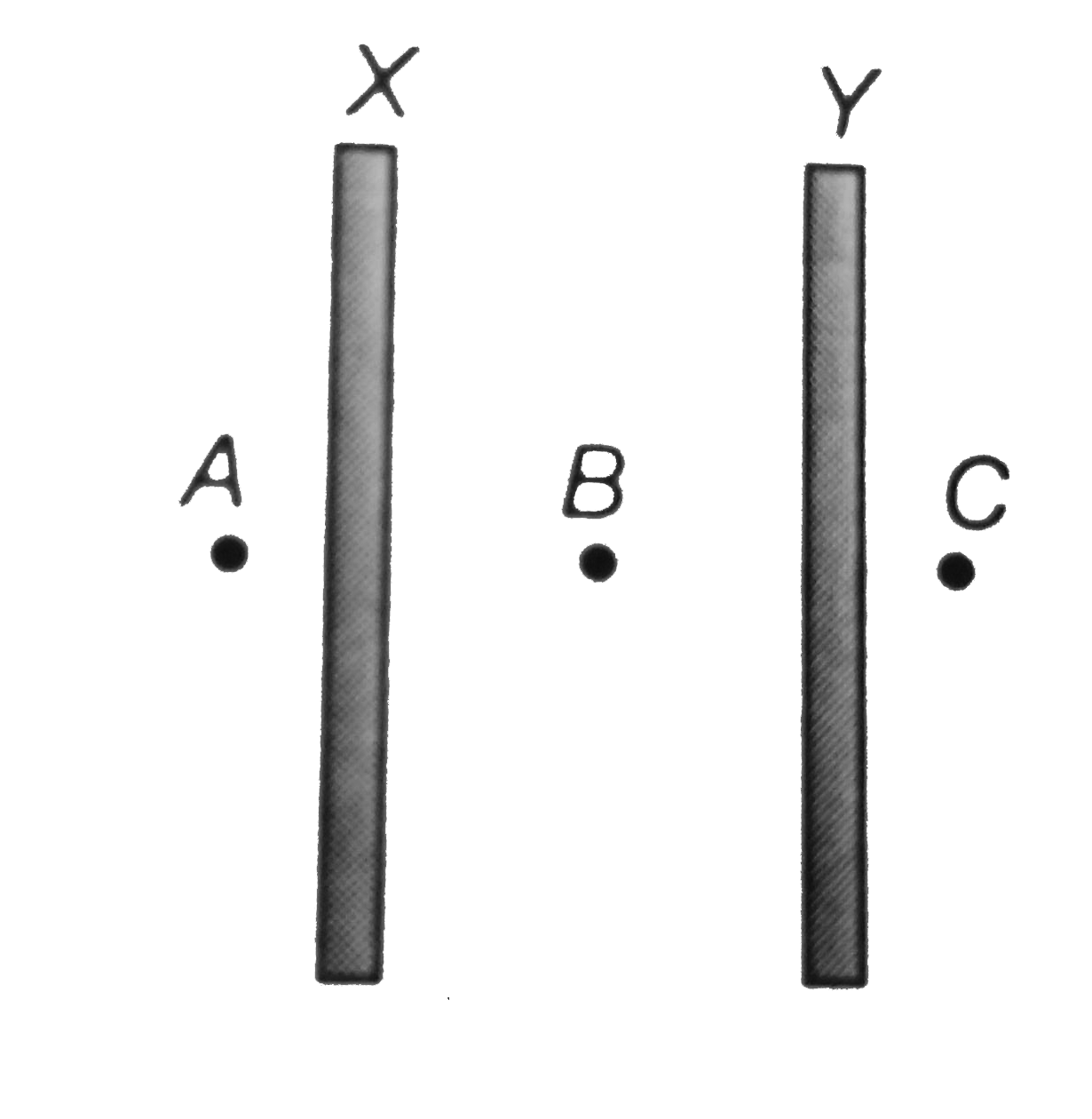Complete Solutions to Advance MCQs of chapter ELECTROSTATICS of Class 12 book with complete answers and questions
| Class 12 | PHYSICS |
| Chapter | ELECTROSTATICS |
| PHYSICS GALAXY | Advance MCQs |
| Number Of Questions | 40 |
| Academic Year | 2023-24 |
A ring with a uniform charge `Q` and radius `R`, is placed in the `yz` plane with its centre at the origin
View SolutionTwo concentric shells have radii R and `2R` charges `q_A` and `q_B` and potentials `2V` and `(3/2)V` respectively. Now, shell B is earthed and let charges on them become `q_A'` and `q_B'`. Then,

View SolutionWhich of the following statement(s) is/are correct?
View SolutionA few electric field lines for a system of two charges `Q_(1)` and `Q_(2)` fixed at two different points on the `x`-axis are shown in the figure. These lines suggest that
(i) `|Q_(1) | gt |Q_(2)|`
(ii) `|Q_(1)| lt |Q_(2)|`
(iii) At a finite distance to the left of `Q_(1)` the electric field is zero
(iv) At a finite distance to the right of `Q_(2)` the electric field is zero

View SolutionA spherical metal shell A of radius `R_A` and a solid metal sphere B of radius `R_B(ltR_A)` are kept far apart and each is given charge `'+Q'`. Now they are connected by a thin metal wire. Then
View SolutionA particle of mass 2 kg chrge 1 mC is projected vertially with velocity k`10 ms^-1`. There is as uniform horizontal electric field of `10^4N//C,` then
View SolutionA cubical region of side a has its centre at the origin. It encloses three fixed point charges, `-q` at `(0,-a//4,0)`, `+3q` at `(0, 0, 0)` and `-q` at `(0, +a//4, 0)`. Choose the correct options(s)

View SolutionThe figure- shows, two point charges `q_(1) = +2Q` and `q_(2) = -Q`. The charges divide the line joining them in three parts I, II and III as shown in figure-1.424 then which_ofthe following statements is/are correct

View SolutionAt distance of `5` cm and `10` cm outwards from the surface of a uniformly charged solid sphere, the potentials are `100 V` and `75 V` respectively. Then:
View SolutionSix point charges are kept at the vertices of a regular hexagon of side L and centre O, as shown in the figure. Given that `K=(1)/(4piepsilon_0)(q)/(L^2)`, which of the following statements is incorrect?

View SolutionPoint charges are located on the comer of a square as shown below. Find the component of electric field at any point on the z-axis which is the axis of symmetry of the square :

View SolutionCharges `Q_1 and Q_2` lie inside and outside, respectively, of a closed surface S. Let E be the field at any point on S and `phi` be the flux of E over S.
View SolutionIn an uniform electric field, when we move from origin to x = Im, the potential changes by 10V. Which of the following can be a possible magnitude of the electric field ?
View SolutionAn electric dipole is placed at the centre of a sphere. Mark the correct options:
View SolutionTwo point charges `Q ` each are placed at `(0,y)` and `(0, -y)` A point charge `q` of the same polarity can move along the x-axis. Then
View SolutionMark the correct options about electric field and Gauss's law in a region of space :
View SolutionThe following figure-I .427 shows a block of mass m suspended from a fixed point by means ofa vertical spring. The block is oscillating simple harmonically and carries a charge q. There also exists a uniform electric field in the space. Consider four different cases. The electric field is zero, in case-I, `E= mg//q` downward in case-2, `E = mg// q` upward in case-3 and `E = 2mg//q` downward in case-4. The speed at mean position of block is same in all cases. Select which of the following statements is/ are correct :

View SolutionTwo concentric spherical shells have charges `+q` and `-q` as shown in figure. Choose the incorrect option.

View SolutionAn insulating rod of uniform linear charge density A and uniform linear mass density `mu` lies on a smooth table whose surface is `xy`-plane. A uniform electric field E is switched on in the space:

View SolutionA rod is hinged (free to rotate) ast its centre O as shown in figue. Two point charge `+q` and `+q` are kept at its two ends. Rod is placed in uniform electric field E as shown. Space is gravity free. Choose the correct options.

View SolutionFigure- shows three spherical shells is separate situations, with each shell having the same uniformly distributed positive charge. Points I, 4 and 7 are at the same radial distances from the centre of the their respective shells so are points 2, 5 and 8 and so are points 3, 6 and 9. With the electric i:otential taken equal to zero at an in finite distance, which of the following statements is/are correct:

View SolutionWhich of the following quantites do not depend on the choice of zero potential or zero potential energy?
View SolutionA charge q is revolving aroW1d another charge q as shown in a conical pendulum. The motion is in a horizontal plane. Which of the following statements is/are correct about this situation :

View SolutionAn electric dipole is placed in an electric field generated by a point charge
View SolutionTwo large thin conducting plates with a small gap in between are placed in a uniform electric field E (perpendicular to the plates.)The area of each plate is A, and charges `+Q and -Q` are given to these plates as shown in figure. If R,S, and T are three points in space, then the

View SolutionThe electric potential decreases Wliforrnly from `1 00`V to `50`V as one moves on the y-axis from y = -Im toy= + l m. The electric field at the origin :
View SolutionA large insulating thick sheet of thickness `2`d is charged with a Wliforrn volume charge density p. A particle of mass m, carrying a charge q having a sign opposite to that of the sheet, is released from the surface of the sheet. The sheet does not offer any mechanical resistance to the motion of the particle. Find the oscillation frequency v of the particle inside the sheet
View SolutionIf the flux of the electric field through a closed surface is zero,
View SolutionThree non-conducting infinite planar sheets are parallel to the y-z plane. Each sheet has an unifomi surface charge density. The first sheet, with a negative surface charge density `sigma,` passes through the x-axis at x = Im. The second sheet has an unknown surface charge density and passes through the x- axis at x = `2`m. The third sheet has a negative surface charge density-`3`cr and passes through the x-axis atx = `4`m. The net electric field due to the sheets is zero at x = `1.5`m. Which of the following is/are correct :
View SolutionAn ellipsoidal cavity is carved within a perfect conductor. A positive charge q is placed at the centre of the cavity. The points A and B are on the cavity surface as shown in the figure. Then

View SolutionA positive charge q is fixed at the origin. An electric dipole withe dipole moment `vecP is placed ,.iong th ex-axis faraway from the origin with vecP pointing along thepositivex-axis and it is set free to move. The kinetic energy .when it reaches a distance x from the origin is Kand the magnitude of the force experienced by charge q at this moment is F. Then :
View SolutionA positively charged thin metal ring of radius R is fixed in the xy plane with its centre at the origin O. A negatively charged particle P is released from rest at the point `(0, 0, z_0)` where `z_0gt0`. Then the motion of P is
View SolutionA spherical symmetric charge system is centered at origin. Given, Electric potential
`V=(Q)/(4piepsilon_0R_0)(rleR_0)`, `V=(Q)/(4piepsilon_0r)(rgtR_0)`

Choose the incorrect statement.
View SolutionA non conducting ring of radius R is charged as shown in figure : Figure

View SolutionUnder the influence of the Coulomb field of charge `+Q`, a charge `-q` is moving around it in an elliptical orbit. Find out the correct statement(s).
View SolutionFigure shows a cross-section ofa spherical metal shell of inner radius R and out radius ZR. A point charge q is ·located at a distanceR/2 from the centre of the shell. If the shell is electrically neutral, then which of the following statements is/are correct :

View SolutionTwo non-conducting solid spheres of radii R and 2R, having uniform volume charge densities `rho_1` and `rho_2` respectively, touch each other. The net electric field at a distance 2R from the centre of the smaller sphere, along the line joining the centres of the spheres, is zero. The ratio `rho_1/rho_2` can be
View SolutionTwo non-conducting spheres of radii `R_1` and `R_2` and carrying uniform volume charge densities `+rho` and `-rho`, respectively, are placed such that they partially overlap, as shown in the figure. At all points in the overlapping region

View Solution`X` and `Y` are large, parallel conducting plates close to each other. Each face has an area `A`. `X` is given a charge `Q`. `Y` is without any charge. Points `A,B` and `C` are as shown in the figure.

View SolutionA particle of charge ` +q` and mass `m` moving under the influence of a uniform electric field ` E hat(i)` and uniform magnetic field ` B hat(k)` follows a trajectory from ` P to Q` as shown in fig. The velocities at `P and Q` are ` v hat(i)` and ` - 2v hat(j)` . which of the following statement(s) is/are correct ?

View Solution
Advance MCQs questions and complete solutions for chapter ELECTROSTATICS of GK PUBLICATIONS PHYSICS (HINGLISH) of Class 12
All Exercises from PHYSICS GALAXY Class 12 PHYSICS ELECTROSTATICS
- Advance MCQs
- Conceptual MCQs single option correct
- Discussion Question
- Illustrative Example
- Numerical MCQs Single options Correct
- Partice Exercise
- Partice Exercise 1.1
- Partice Exercise 1.10
- Partice Exercise 1.2
- Partice Exercise 1.3
- Partice Exercise 1.4
- Partice Exercise 1.5
- Partice Exercise 1.6
- Partice Exercise 1.7
- Partice Exercise 1.8
- Partice Exercise 1.9
- Unsolved Numberical Problems